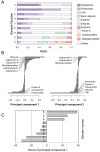Diversity in protein profiles of individual calcium oxalate kidney stones
- PMID: 23874695
- PMCID: PMC3706363
- DOI: 10.1371/journal.pone.0068624
Diversity in protein profiles of individual calcium oxalate kidney stones
Abstract
Calcium oxalate kidney stones contain low amounts of proteins, some of which have been implicated in progression or prevention of kidney stone formation. To gain insights into the pathophysiology of urolithiasis, we have characterized protein components of calcium oxalate kidney stones by proteomic approaches. Proteins extracted from kidney stones showed highly heterogeneous migration patterns in gel electrophoresis as reported. This was likely to be mainly due to proteolytic degradation and protein-protein crosslinking of Tamm-Horsfall protein and prothrombin. Protein profiles of calcium oxalate kidney stones were obtained by in-solution protease digestion followed by nanoLC-MALDI-tandem mass spectrometry, which resulted in identification of a total of 92 proteins in stones from 9 urolithiasis patients. Further analysis showed that protein species and their relative amounts were highly variable among individual stones. Although proteins such as prothrombin, osteopontin, calgranulin A and calgranulin B were found in most stones tested, some samples had high contents of prothrombin and osteopontin, while others had high contents of calgranulins. In addition, calgranulin-rich stones had various neutrophil-enriched proteins such as myeloperoxidase and lactotransferrin. These proteomic profiles of individual kidney stones suggest that multiple systems composed of different groups of proteins including leucocyte-derived ones are differently involved in pathogenesis of individual kidney stones depending on situations.
Conflict of interest statement
Figures






References
-
- Tsujihata M (2008) Mechanisms of calcium oxalate renal stone formation and renal tubular cell injury. Int J Urol 15: 115–120. - PubMed
-
- Robertson WG, Peacock M, Nordin BEC (1968) Activity products in stone-forming and non-stone forming urine. Clin Sci 34: 579–594. - PubMed
-
- Boyce WH (1968) Organic matrix of human urinary concretions. Am J Med 45: 673–683. - PubMed
-
- Maxfield M (1963) Urinary mucopolysaccharides and calculi. Ann Rev Med 14: 99–. - PubMed
-
- Kohri K, Nomura S, Kitamura Y, Nagata T, Yoshioka K, et al. (1993) Structure and expression of the mRNA encoding urinary stone protein (osteopontin). J Biol Chem 268: 15180–15184. - PubMed
Publication types
MeSH terms
Substances
Supplementary concepts
LinkOut - more resources
Full Text Sources
Other Literature Sources
Research Materials

